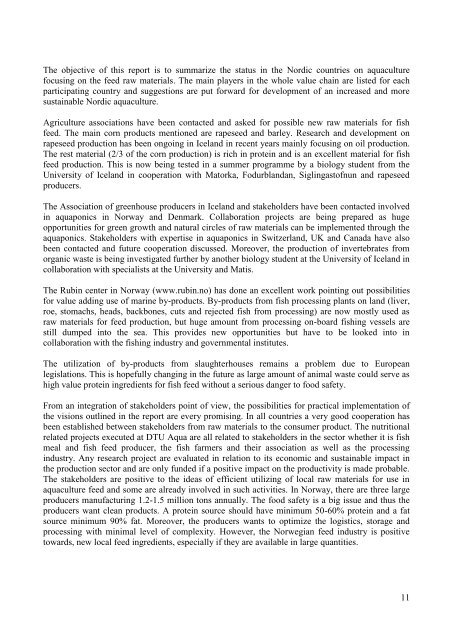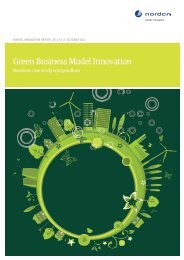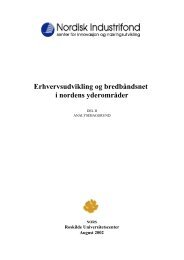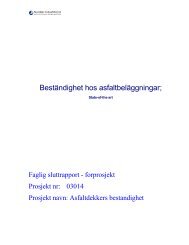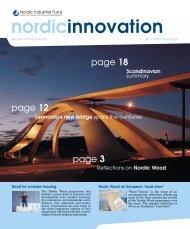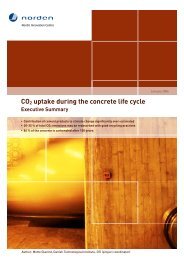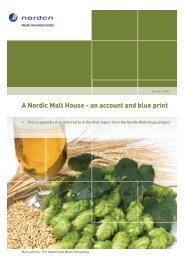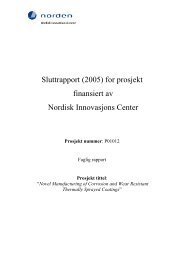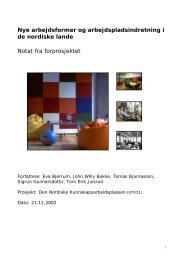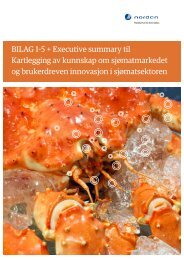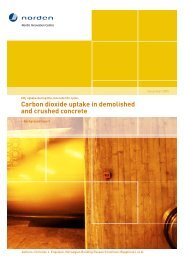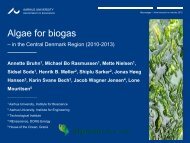Local raw materials for production of fish feed for ... - Nordic Innovation
Local raw materials for production of fish feed for ... - Nordic Innovation
Local raw materials for production of fish feed for ... - Nordic Innovation
You also want an ePaper? Increase the reach of your titles
YUMPU automatically turns print PDFs into web optimized ePapers that Google loves.
The objective <strong>of</strong> this report is to summarize the status in the <strong>Nordic</strong> countries on aquaculture<br />
focusing on the <strong>feed</strong> <strong>raw</strong> <strong>materials</strong>. The main players in the whole value chain are listed <strong>for</strong> each<br />
participating country and suggestions are put <strong>for</strong>ward <strong>for</strong> development <strong>of</strong> an increased and more<br />
sustainable <strong>Nordic</strong> aquaculture.<br />
Agriculture associations have been contacted and asked <strong>for</strong> possible new <strong>raw</strong> <strong>materials</strong> <strong>for</strong> <strong>fish</strong><br />
<strong>feed</strong>. The main corn products mentioned are rapeseed and barley. Research and development on<br />
rapeseed <strong>production</strong> has been ongoing in Iceland in recent years mainly focusing on oil <strong>production</strong>.<br />
The rest material (2/3 <strong>of</strong> the corn <strong>production</strong>) is rich in protein and is an excellent material <strong>for</strong> <strong>fish</strong><br />
<strong>feed</strong> <strong>production</strong>. This is now being tested in a summer programme by a biology student from the<br />
University <strong>of</strong> Iceland in cooperation with Matorka, Fodurblandan, Siglingast<strong>of</strong>nun and rapeseed<br />
producers.<br />
The Association <strong>of</strong> greenhouse producers in Iceland and stakeholders have been contacted involved<br />
in aquaponics in Norway and Denmark. Collaboration projects are being prepared as huge<br />
opportunities <strong>for</strong> green growth and natural circles <strong>of</strong> <strong>raw</strong> <strong>materials</strong> can be implemented through the<br />
aquaponics. Stakeholders with expertise in aquaponics in Switzerland, UK and Canada have also<br />
been contacted and future cooperation discussed. Moreover, the <strong>production</strong> <strong>of</strong> invertebrates from<br />
organic waste is being investigated further by another biology student at the University <strong>of</strong> Iceland in<br />
collaboration with specialists at the University and Matis.<br />
The Rubin center in Norway (www.rubin.no) has done an excellent work pointing out possibilities<br />
<strong>for</strong> value adding use <strong>of</strong> marine by-products. By-products from <strong>fish</strong> processing plants on land (liver,<br />
roe, stomachs, heads, backbones, cuts and rejected <strong>fish</strong> from processing) are now mostly used as<br />
<strong>raw</strong> <strong>materials</strong> <strong>for</strong> <strong>feed</strong> <strong>production</strong>, but huge amount from processing on-board <strong>fish</strong>ing vessels are<br />
still dumped into the sea. This provides new opportunities but have to be looked into in<br />
collaboration with the <strong>fish</strong>ing industry and governmental institutes.<br />
The utilization <strong>of</strong> by-products from slaughterhouses remains a problem due to European<br />
legislations. This is hopefully changing in the future as large amount <strong>of</strong> animal waste could serve as<br />
high value protein ingredients <strong>for</strong> <strong>fish</strong> <strong>feed</strong> without a serious danger to food safety.<br />
From an integration <strong>of</strong> stakeholders point <strong>of</strong> view, the possibilities <strong>for</strong> practical implementation <strong>of</strong><br />
the visions outlined in the report are every promising. In all countries a very good cooperation has<br />
been established between stakeholders from <strong>raw</strong> <strong>materials</strong> to the consumer product. The nutritional<br />
related projects executed at DTU Aqua are all related to stakeholders in the sector whether it is <strong>fish</strong><br />
meal and <strong>fish</strong> <strong>feed</strong> producer, the <strong>fish</strong> farmers and their association as well as the processing<br />
industry. Any research project are evaluated in relation to its economic and sustainable impact in<br />
the <strong>production</strong> sector and are only funded if a positive impact on the productivity is made probable.<br />
The stakeholders are positive to the ideas <strong>of</strong> efficient utilizing <strong>of</strong> local <strong>raw</strong> <strong>materials</strong> <strong>for</strong> use in<br />
aquaculture <strong>feed</strong> and some are already involved in such activities. In Norway, there are three large<br />
producers manufacturing 1.2-1.5 million tons annually. The food safety is a big issue and thus the<br />
producers want clean products. A protein source should have minimum 50-60% protein and a fat<br />
source minimum 90% fat. Moreover, the producers wants to optimize the logistics, storage and<br />
processing with minimal level <strong>of</strong> complexity. However, the Norwegian <strong>feed</strong> industry is positive<br />
towards, new local <strong>feed</strong> ingredients, especially if they are available in large quantities.<br />
11


